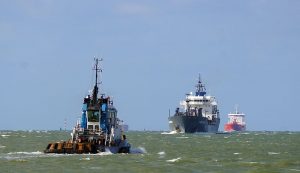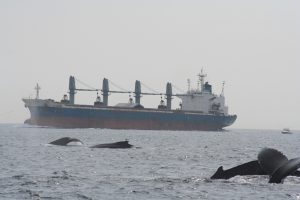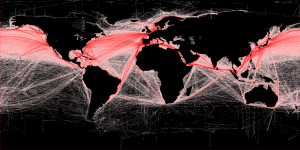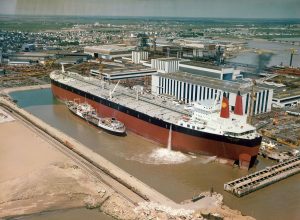By Daniela Escontrela, RJD Intern
A topic of concern in the past few years has been noise pollution in the ocean. Particularly, noise pollution has been thought to affect marine mammal populations since they are so reliant on acoustics for navigation and communication (Erbe 2011). Marine mammals are of special conservation concern because they have been so heavily exploited in the past century via whaling and bycatch (Tyack 2009). The marine mammal protection act was developed 1972 and aimed at protecting and conserving marine mammals and their natural habitats (Tyack et al 2003). However, at the time the marine mammal protection act was passed many of the regulations were based on the pressures of whaling. Now that whaling is better controlled, it is possible that degradation of habitat from multiple sources may pose a bigger threat to marine mammals. One of these impacts that may be causing degradation to marine mammal populations and their environment is noise pollution. (Tyack 2009) The marine soundscape can be complex and for this reason it is hard to study effects of anthropogenic noise on marine mammals. In addition to anthropogenic sounds such as those that come from ships, petroleum exploration and naval sonar, among others, the marine soundscape is also made up of natural ambient sounds such as wind and waves and biological sounds such as calls emitted from marine mammals, fish and crustaceans. (Erbe 2011) This intricate combination of sounds in combination with lack of adequate technology and the difficulty of studying these sometimes elusive animals has made this area of study a hard one.
In 1971 biologist Roger Payne and engineer Douglas Webb were among the first to raise concern over how anthropogenic noise could affect marine mammals. It had been recently discovered that baleen whales used special calls for reproductive purposes. These calls could usually be detected as far away as 280 km away, however, Payne and Webb calculated that with increased ambient noise due to modern commercial ships, these calls were being masked and could only be detected at 90 km distance now. (Tyack 2009) Anthropogenic noise can also mask echolocation clicks which are used by Odontocetes (toothed whales) for finding food and navigation and it can also mask environmental noises that animals listen to such as surf and approaching predators. (Erbe Farmer 2000) If noise masks communication signals, this can disrupt mating systems or parental care and affect reproduction and survival of young in endangered populations. (Tyack 2009) Anthropogenic noises have also been seen to disrupt normal behaviors such as cessation of feeding, resting, socializing and onset of alertness or avoidance. (Erbe Farmer 2000) If foraging is affected by noise this can cause animals to grow more slowly (Tyack 2009). These man made noises can even cause damage to hearing by decreasing auditory sensitivity which can be permanent or temporary. However different animals have different sensitivities and are impacted differently, for example mystecetes (baleen whales) are more sensitive at lower frequencies. (Erbe Farmer 2000)
Early experiments tracked migrating gray whales (mystecetes) as they traveled the corridor of California and found that these whales were sensitive at certain pressure levels when sounds that imitated those from ships or dill rigs were played back to them. Migrating bowhead whales traveling past seismic survey vessels were also studied and found to be sensitive at certain pressure levels. In fact these whales wouldn’t come within 20 km of these areas because the air guns used in these surveys were so intense. It has been shown that many mystecetes show avoidance of certain areas were such loud noises occur. Odontocetes have been harder to study because of their prolonged dives, sometimes exceeding an hour. In the little research that has been done, Odontocetes don’t show the same avoidance of anthropogenic noises that mystecetes show. One study used tagged sperm whales to see how they would respond to the air guns used by seismic survey vessels. The whales were satellite tagged and seismic survey vessels ramped up their air gun array and conducted controlled approaches to tagged whales. None of the seven whales tagged seemed to avoid the vessel. One of the whales remained on the surface and only began a foraging dive after the noise had ceased. The other six whales that were tagged continued their foraging dives. What was found however was that these whales were seen to reduce their swimming effort and they reduced their attempts at catching prey. This suggests not an avoidance pattern like some mystecetes but instead a behavior change, in this case foraging behavior was altered. (Tyack 2009)
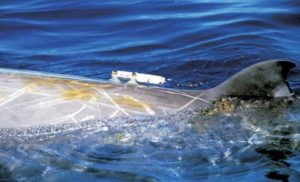
An image of the satellite tag used by Tyack fitted onto the back of a sperm whale
Seismic surveys and pile driving can produce some of the most intense anthropogenic noises in the marine environment. How these activities affect marine species depends on how well the sound propagates underwater, its frequency characteristics and its duration. In a study by Bailey et al 2010 measures of pile driving noise levels were made in NW Scotland. Specifically, they were made during the construction of two offshore wind turbines close to a special area of conservation were a protected population of bottlenose dolphins resided. They found a decrease in sound pressure and an increase in duration with increasing distance from the pile driving site. In fact, noise levels produced during pile-driving were detectable above background underwater noise levels at a distance of 70km. These noise levels were related to noise criteria for marine mammals and they found that bottlenose dolphins and minke whales could exhibit behavioral disturbance up to 50km away and any zones of auditory injury and temporary threshold shifts were likely to have been within a range of 100m. (Bailey et al 2010)

A graph of peak to peak sound pressure levels from pile-driving activities in relation to distance from the noise source.
Another area of concern when it comes to noise pollution is the naval sonar exercises. In 1998 a letter in the journal nature attributed the cause of the atypical mass stranding of beaked whales to a naval exercise in the area. The same happened again in 2000 in the Bahamas. As of today scientists know of one or two dozen atypical strandings of beaked whales that coincided with the presence of naval ships in the area. One proposition for this is that beaked whales are especially sensitive to these noises although as of date there is no evidence to support this. Another hypothesis is that the naval sonar signals are similar to calls of killer whales which are predators of the beaked whales. It was then proposed that beaked whales may be showing antipredator response since these signals are so similar. This hypothesis was tested with three satellite tagged beaked whales that were exposed to naval sonar signals and calls of marine mammals eating whales. Although the whales didn’t show antipredator response to the extent of stranding, the whales did stop clicking in response to the sound stimulus and in particular reduced their foraging activity. (Tyack 2009)
Another area of concern is how explosives may affect marine mammals. In particular, aside from behavioral changes, how the ear may be affected from this high intensity explosions. Marine mammals evolved from land mammals and such both have similar ears. However, marine mammals have not only had to adapt their ears to the high pressures they encounter during dives but they have also had to develop adaptations to deal with the high noise environment in which they live. The two views are that since marine mammals rely so much on hearing, they can suffer impacts from even minor acoustic trauma. On the other hand, since they have adapted their ears to this high noise environment and since they rely so much on hearing for their lifestyle they are well protected. In a study by Ketten a model was used to asses theoretical pressures that marine mammals may encounter within a 15 km radius of a multi-tonnage mid water explosion. In her study she found that at certain distances and pressures, these blasts could not only cause trauma to the ear but these explosions could indeed be lethal. (Ketten 1995) in other experiments it has been found that noise produced by air gun arrays and explosives could be so intense that it could injure animals in the vicinity. In fact US regulations stipulate that such sound sources be shut down if a marine mammal enters the zone of potential injury. (Tyack 2009)
The studies that have been done so far have shown that marine mammals could indeed be harmed and affected by these anthropogenic noises. However, a lot of these studies have been species specific and it can be hard to extrapolate these results to all marine mammals since they all have different hearing sensitivities. In addition, it is hard to determine whether the responses observed in these studies are due anthropogenic noises or something else. Causation can be hard to study in the wild since there can be so many factors that come into play. Our understanding is limited and there is always the possibility that these animals have evolved to deal with all these noises and more. In fact other studies have shown that some marine mammals can compensate for noise to some point. They can increase the level of their calls, shift their signals out of the noise band or they wait to signal until the noise is reduced. Although we see that animals have been able to adapt it is noteworthy to mention that these adaptations may come with an energy expenditure to the animal. (Tyack 2009)
Future research might focus on using a software that was developed by Erbe and Farmer. They argue that to understand over which range anthropogenic noise impacts marine mammals, we need to understand how the noise propagates away from the noise source and we also need to understand the relationship between received noise levels and impact thresholds. They present a software that does both of these things and in this way we can estimates zones of impact on marine mammals around anthropogenic noises. (Herbe and Farmer 2000) Other research might also focus on controlled exposure experiments (CCEs) as proposed by Tyack et al. This type of research focuses on determining the response of animals to signals that aren’t part of their normal communicative range. Certain considerations need to be taken into account such as selection of subjects and stimuli which should be appropriate to the hypothesis and experiments should be designed to have biological relevance and test biologically significant responses. (Tyack et al 2003)
The science is hard but in due time we might be able to understand how these complex animals are affected by such a wide array of man made noises. However, once this knowledge gap is filled and we finally understand how each species is affected by different anthropogenic noises this begs the question of what will happen next. But more importantly we wonder if we will gather the knowledge in time to save some of these already at risk populations that might be deleteriously affected by anthropogenic sounds.
Works Cited:
Bailey, H., Senior, B., Simmons, D., Rusin, J., Picken, G., & Thompson, P. M. (2010). Assessing underwater noise levels during pile-driving at an offshore windfarm and its potential effects on marine mammals. Marine Pollution Bulletin, 60(6), 888-897.
Erbe, C. (2011). The effects of underwater noise on marine mammals. The Journal of the Acoustical Society of America, 129(4), 2538.
Erbe, C., & Farner, D. M. (2000). A software model to estimate zones of impact on marine mammals around anthropogenic noise. The Journal of the Acoustical Society of America, 108(3), 1327-1331.
Ketten, D. R. (1995). Estimates of blast injury and acoustic trauma zones for marine mammals from underwater explosions. Sensory systems of aquatic mammals, 391-407.
Tyack, P. L. (2009). Human Generated Sound and Marine Mammals. Physics Today, 62(11), 39-44.
Tyack, P., Gordon, J., & Thompson, D. (2003). Controlled Exposure Experiments to Determine the Effects of Noise on Marine Mammals. Marine Technology Society Journal, 37(4), 41-53.



